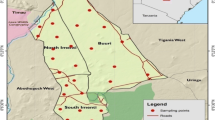Abstract
The study looked at the levels of pesticides in okra grown close to a watermelon farm herein referred to as a non-target crop. The watermelon received some pesticide application in the course of its cultivation, and the okra which was not meant to be sprayed was also affected by the pesticide. About 500 okra samples were collected for a period of 6 weeks and pesticides extracted with 1:1 n-hexane and dichloromethane which was analysed with Agilent 2222 GC/MS coupled with 389 auto-sampler. The results confirmed accumulation of significant levels of pesticides in the non-target crop (okra grown close to watermelon farm). Levels of organochlorine pesticides ranged from 3.10 to 7.60 μg/kg whilst the organophosphorus pesticides had levels ranging from 2.80 to 2016.80 μg/kg. The synthetic pyrethroid pesticide mean levels also ranged from 0.10 to 4.10 μg/kg and were below World Health Organization/Food and Agriculture Organization-recommended residue levels, and though not appearing to constitute a grave threat to life, their occurrence is a concern, and pre-emptive techniques must be developed to thwart the contaminations. Though the non- target crop was not treated directly with the pesticides, some level of contamination with organochlorine and organophosphorus pesticides persisted in the crops. It can be inferred that application of pesticides affected the adjoining crops, meaning that inter-cropping and mix-cropping might not be acceptable when one of the crops requires pesticide application. It is important for the farmers to be trained to ensure proper application of pesticide to minimise its impact on the health of consumers.
Similar content being viewed by others
References
Colborn, T., Dumanoski, D., & Myers, J. P. (1996). Our stolen future. Penguin, New York, NY.
Colborn, T., vom Saal, S., & Soto, A. M. (1993). Developmental effects of endocrine-disrupting chemicals in wildlife and humans. Environmental Health Perspectives, 101(5), 378–384.
CropLifeInternational. (2003). Acutely toxic pesticides: Risk assessment, risk management and risk reduction in developing countries and economies in transition.
Curl, C. L., Fenske, R. A., & Elgethum, K. (2003). Organophosphorus pesticide exposure of urban and suburban preschool children with organic and conventional diet. Environmental Health Perspectives, 111(5), 377–382.
David, B. V. (1992). In S. Indian (Ed.), Pest management and pesticides (p. 384). Madras: Namrutha Publications.
Essumang, D. K., Dodoo, D. K., Adokoh, C. K., & Fumador, E. A. (2008). Analysis of some pesticides residues in tomatoes in Ghana. Human and Ecological Risk Assessment, 14, 796–806.
Gupta, P. K. (2004). Pesticides exposure—Indian scene. Toxicology, 198, 83–90.
Hewitt, A. J. (2000). Spray drift: impact of requirements to protect the environment. Crop Protection, 19(2000), 623–627.
Kolpin, D. W., & Martin, J. D. (2003). Pesticides in ground water of the United States: Summary of results of the National Water Quality Assessment Program 1991–2001. Sacramento, CA.
Kookana, R. S., Baskara, S., & Naidu, R. (1998). Pesticide fate and behaviour in Australian soils in relation to contamination and management of soil and water: A review. Australian Journalof Soil Research, 36, 715–764.
Krieger, R. (2001). Handbook of pesticide toxicology. San Diego: Academic Press.
Liu, Y. Y., & Xiong, Y. (2001). Purification and characterization of a dimethoate-degrading enzyme of Aspergillus niger ZHY 256 isolated from sewage. Applied and Environmental Microbiology, 67, 3746–3749.
Luke, M. A., Frodberg, J. E., Doose, G. M., & Mosumoto, H. T. (1981). Improved multiresidue chromatographic determination of organphosphorus, organonitrogen and organochlorine pesticides using flame photometric and electrolytic conductivity detectors. Journal of the Association of Analytical Chemists, 64, 1187–1195.
Marquardt, S., Cox, C., & Knight, H. (1998). Toxic secrets: “Inert” ingredients in pesticides 1987–1997. Northwest Coalition for Alternatives to Pesticides. Eugene, OR
Matsumura, F. (1985). Toxicology of insecticides (2nd ed.). New York: Plenum.
Murphy, S. D. (1986). Toxic effects of pesticides. In: Casarett and Doull’s Toxicology. The basic science of poisons. McGraw-Hill, New York, NY
Pang, G. F., Chao, Y. Z., Liu, X. S., & Fan, C. L. (1995). Multiresidue liquid chromatographic method for simultaneous determination of organophosphorus pesticides in fruits and vegetables. Journal of the Association of Official Analytical Chemists, 76(6), 1474–1480.
Smith, A. G., & Gangolli, S. D. (2002). Organochlorine chemicals in seafood: Occurrence and health concerns. Food and Chemical Toxicology, 40, 767–779.
Song, L., Seeger, A., & Santos-Sacchi, J. (2005). Membrane motor activity and chloride flux in the outer hair cell: Lessons learned from the environmental toxin tributyltin. Biophysical Journal, 88, 2350–2362.
Sumpter, J. P., & Johnson, A. C. (2005). Lessons from endocrine disruption and their application to other issues concerning trace organics in the aquatic environment. Environmental Science and Technology, 39(12), 4321–4332.
WHO. (1998). Recommended classification of pesticides by hazard and guidlines to classification. World Health Organization, Geneva, Switzerland
WHO/FAO. (2006). Maximum Residues limits for pesticides in food and animal feeds.
William, R. D., Burrill, L. C., Ball, D., Miller, T. L., Parker, R., & Al-Khatib, K. (1995). Pacific Northwest weed control 1995 (p. 358). Carvallis,OR: Oregon State University Extension Service.
Author information
Authors and Affiliations
Corresponding author
Appendices
Appendices
Rights and permissions
About this article
Cite this article
Essumang, D.K., Asare, E.A. & Dodoo, D.K. Pesticides residues in okra (non-target crop) grown close to a watermelon farm in Ghana. Environ Monit Assess 185, 7617–7625 (2013). https://doi.org/10.1007/s10661-013-3123-5
Received:
Accepted:
Published:
Issue Date:
DOI: https://doi.org/10.1007/s10661-013-3123-5




